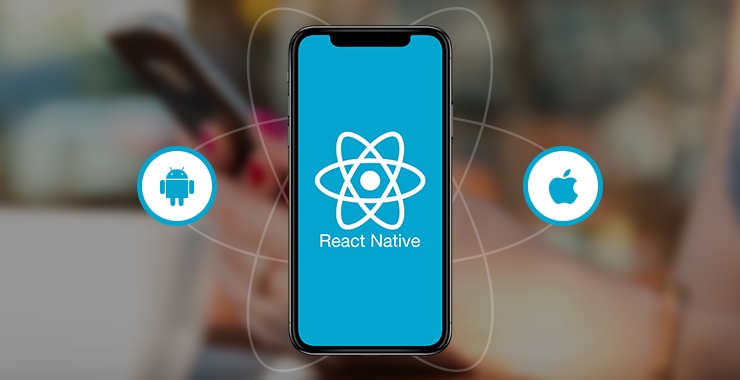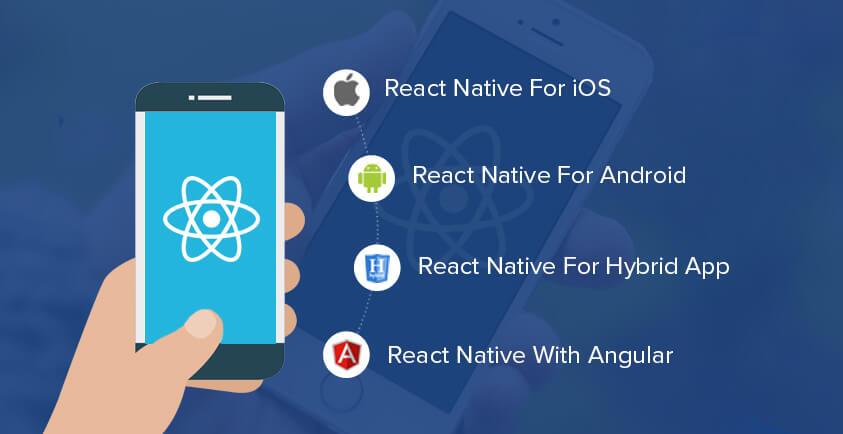
A lot of considerations take place as one decides to get a mobile app for their business. There are a lot of questions that one has to find answers to, a lot of decisions that needs to be made as it comes to the mobile app development. Should I build an app for iPhone or Android? Which framework will best suit my app? Which programming language should I choose? Which of the mobile app development firm should I pick to get a mobile app created? This are the common decisions that one requires to make.
Now, once pondered upon them, people realize that both iOS and Android markets are on the boom, however, the next worry comes in the form of the expense. After all, wouldn’t it be an expensive affair to get an app developed for both of the platforms? Well, not when you choose React Native as your framework.
Creating separate applications for both of the platforms is called native that is best in terms of performance. React Native App Development uses same code for both of the platforms and still delivers a performance that is pretty much as smooth and efficient as native. Rest of the cross-platform framework could be better in terms of time and cost, but they won’t be as amazing as React Native, as it comes to performance. React Native saves everything from time, energy, and efforts.
What is React Native?

Basically, it is a JavaScript framework that is designed to build genuine native applications for the platforms such as Android & iOS. This framework is based on a JavaScript library that is created by Facebook, and is known as React, and it adds power to the native mobile application development. It works well with the mobile application development market requirements of todays, where there is often confusion with the two operating systems that are dominating the arena. Hence often the firms that create the apps need to make this common decision: whether to create apps that offer a better user experience or the apps which are faster to create and develop on the more platforms & devices.
Now this concept of developing apps with the use of just one paradigm for all the platforms may sound slight unbelievable, but React Native is a right decision to make, despite its immaturity. React Native allows the acceleration of process of creating the apps across various platforms, owing to the prospect to reuse most of the codes between them.
The component of React Native are pure and free of any side-effects and they return what views appear like at any given point. This is why writing state-dependent views is easier as here you are not required to care about updating view as the state changes as the framework will do that for you. Even the UI is rendered with the use of actual native views, hence final UX (user-experience) is also not bad as compared to the other solutions that just render web component inside a WebView.
React Native allows to use the same code for both of the platforms and it still delivers a near-to-native performance. Other of the cross-platform frameworks are better in terms of time and cost but they are not as brilliant as React Native as it comes to the performance. React Native saves everything from energy, time and efforts.
Meanwhile, there are a few categories that best suit React Native framework, and below we have mentioned the apps that can be developed using React Native.
Types of Mobile Apps best-suited for React Native:
#1 Prototypes Apps: In case your app has the motive to create a prototype for showcasing it to its investors, then no option can be better than React Native, which is budget-friendly, quick and offers smooth & efficient performance. It offers lightweight User Interface with the limited functionality at amazingly fast speed.
#2 Cross-Platform Applications: In case your idea is creating an MVP or an app with basic features, then go with React Native, which is an ideal fit for simple & straightforward mobile apps. Now even when you are picking heavy apps, then the amount of efforts and time required with an app based on React Native is a lot less as compared to native ones. Still, it is considered best for simple and lightweight apps.

Types of Apps that doesn’t suit React Native:
#1 Apps that require Native API:
In case of React Native, it best suits the apps having a specific purpose and have a simple design. Thus, for the apps that heavily rely on the native API won’t work well with React Native framework. For apps requiring native API, it is best that they work with native languages such as Kotlin or Swift for the app development. As here with apps with the native API, both the development & performance is going to be a lot better as compared to react native. Also react native is prominent for taking lesser efforts and time, which doesn’t apply with these applications. Hence, it is advised to make a wise decision here and go with a framework that is suitable for your app type.
#2 Gaming Apps:
These kind of apps require highly supreme user-interface and React Native is not apt for this purpose of say it can’t work well with the design-based applications. Gaming apps are integrated with the heavy graphics and rich features, and hence React Native won’t be the best choice for these apps, as here they may suffer in terms of performance. Next, we have discussed few of the big brands that use React Native and why they are using it.
Big Brands that are using React Native:-
1) Facebook:
As mentioned above as well, React Native was the hackathon project of Facebook which was develop to meet the requirements of the firm. Facebook was keen to make the most of the advantages that came with web development like quick iterations & having a single team for developing the entire product to mobile. And hence, React Native came in and leveraged in the mobile app development for both Android & iOS apps.
Now Facebook developed React Native only to support iOS initially, however quite recently it started supporting Android operating system and now the library provides offers mobile UI for both of these platforms. React Native was used by Facebook to create its own Ads Manager app, developing both Android and iOS versions and both were developed by the same development team. Facebook even made React Native an open-source with the motive that its compatibility with the other platforms such as tvOS or Windows can be operated on by development community.
This decision to create on React Native resulted in improved performance. In fact, even the Events Dashboard startup is twice faster now. Most advanced were made at framework level and this determines that your React Native app will benefit automatically when it is transferred to latest version of React Native.
2) Facebook Ads:
Apart from the Facebook’s social networking platform, the Facebook Ads was React Native’s first app for the Android. In fact, it was the first completely based on React Native and cross-platform mobile app built in there. This framework is apt for a number of complex business logic needed to accurately handle the differences in the ad formats, date formats, currencies, time zones, currency conventions, and a lot more.
The main reason behind going for React Native was its clean interface. It had intuitive UX & simple navigation. Both the transitions and animations are perfect here and in no way do they appear buggy or irrelevant. Due to the amazing experience Facebook highly recommends the marketing teams to use this app. No matter what options you perform on the app, be it to check your current campaign’s status or to build a new one, the app stays superfast. It just needs a second or two for navigating to next level or to access the data easily.
3) Gyroscope:
This health mobile app on steroids allow you to see your whole life story. It is able to track steps, heart rate, your workout, and even track activities such as productivity on computer or use a sleep tracker & automatic Ai to ensure sound sleep. By coming with React Native, the entire of app data is displayed in two appealing views, i.e. Simple & Cards mode. Here all of the tracked data is aggregated in the daily/weekly/monthly statements. It also allow to deep-dive into it easily and pick up on what you want to focus on next.
Creating the new consumer mobile app was a massive effort as it required transitioning the whole organization to React Native. The result was that it automated code refreshes and accelerates release of the new product features. Thus, instead of recompilation, your app instantly reloads.
4) Instagram:
Instagram also took the plunge of integrating React Native into its existing Native application, and it began from the simplest view, i.e. Push Notification view. Basically, it was implemented as WebView, and didn’t require creating navigation infrastructure as its UI was pretty simple. Instagram’s development team faced many problems while transitioning but significantly enhanced developer velocity. Here, 85 percent to 99 percent of the code was shared between iOS & Android apps, as per the products. This way the team succeeded in delivering the app a lot faster.
5) Bloomberg:
The brand’s newly introduced consumer mobile app for Android & iOS offers an interactive and streamlined experienced to the client with easily accessible personalized content, and videos and live feeds featured across the Bloomberg’s Media. To create the app, the firm employed this amazing framework to deliver a cross-platform native app development.
6) Walmart:
Well, this brand has already proven how innovative it is by introducing Node.js in its stack. And just a few years later, they revised their app into React Native. Thus allowed Walmart to enhance performance on both Android and iOS apps using lesser resources and within shorter span of time. Its 96 percent code were shared between platforms whereas the skills & experience of the developers were leveraged across the enterprise.
The reason why Walmart chose React Native was because it aims high and desire to become the largest online retailer on a global level. Hence, to fulfill these dreams, the firm requires to take the bold moves involving higher risk so to get a competitive advantage. This is the reason that they always look for ways and try new technologies to enhance the customer experience.
Reluctantly, today Walmart app with React Native offers performs greatly, in fact very much near to the native applications and offers very smooth animations.
How To Select A Mobile App Development Company?: Read More
Well, it is clear that there are immense benefits of creating an app on React Native framework and all you have to do is to check whether your app is suitable to be created on this framework. If everything works in the favour, then anything works best than to create an app on React Native, as here you can build the app for both the platforms that too without spending too much money or time.

